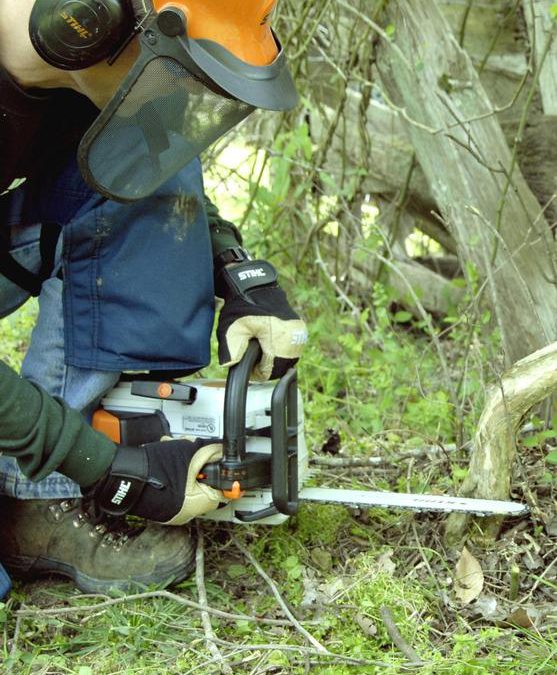
by Mary Salinas | Oct 29, 2018
When there is so much to do in cleaning up after a storm, sometimes we tend to do too much so that it can all get done. Be safe, don’t add to the disaster.
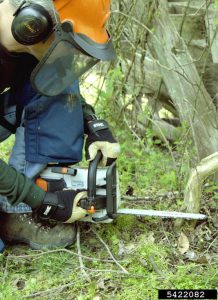
Be careful with that chainsaw! Photo credit: James H. Miller, USDA Forest Service, Bugwood.org.
Here are some suggestions:
- Take breaks and rest often. Mistakes happen when people are exhausted.
- Only lift what you can comfortably handle, lifting with your legs and not your back. Get a buddy to help with heavier objects or wait until a team or equipment can assist.
- Make sure you are adequately hydrated. Always keep water nearby and take a long drink during your breaks.
- Protect yourself against biting pests such as mosquitoes with insect repellent.
- Wear protective gloves, sturdy closed toe shoes and long pants.
- Have a first-aid kit available for minor injuries.
- Make sure ladders are stable and locked into position.
- If you are using any type of power equipment, especially a chainsaw, make sure someone else is around. And protective gear is a must. Read about details in this article.
by Mary Salinas | Oct 20, 2018
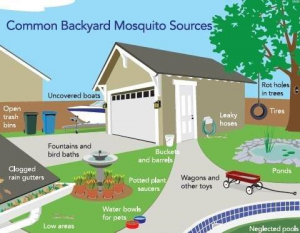
A natural disaster such as Hurricane Michael can cause excess standing water which leads nuisance mosquito populations to greatly increase. Floodwater mosquitoes lay their eggs in the moist soil. Amazingly, the eggs survive even when the soil dries out. When the eggs in soil once again have consistent moisture, they hatch! One female mosquito may lay up to 200 eggs per batch . Standing water should be reduced as mush as possible to prevent mosquitoes from developing.
You should protect yourself by using an insect repellant (following all label instructions) with any of these active ingredients or using one of the other strategies:
- DEET
- Picaridin
- Oil of lemon eucalyptus
- Para-menthane diol
- IR3535
- An alternative is to wear long-sleeved shirts and pants – although that’s tough in our hot weather
- Wear clothing that is pre-treated with permethrin or apply a permethrin product to your clothes, but not your skin!
- Avoid getting bitten while you sleep by choosing a place with air conditioning or screens on windows and doors or sleep under a mosquito bed net.
Now let’s talk about mosquito control in your own landscape.
Let’s first explore what kind of environment in your landscape and around your home is friendly to the proliferation of mosquitoes. Adult mosquitoes lay their eggs on or very near water that is still or stagnant. That is because the larvae live in the water but have to come to the surface regularly to breeze. The small delicate larvae need the water surface to be still in order to surface and breathe. Water that is continually moving or flowing inhibits mosquito populations.
Look around your home and landscape for these possible sites of still water that can be excellent mosquito breeding grounds:
- bird baths
- potted plant saucers
- pet dishes
- old tires
- ponds
- roof gutters
- tarps over boats or recreational vehicles
- rain barrels (screen mesh over the opening will prevent females from laying their eggs)
- bromeliads (they hold water in their central cup or leaf axils)
- any other structure that will hold even a small amount of water (I even had them on a heating mat in a greenhouse that had very shallow puddles of water!)
You may want to rid yourself of some of these sources of standing water or empty them every three to four days. What if you have bromeliads, a pond or some other standing water and you want to keep them and yet control mosquitoes? There is an environmentally responsible solution. Some bacteria, Bacillus thuringiensis ssp. israelensis or Bacillus sphaericus, only infects mosquitoes and other close relatives like gnats and blackflies and is harmless to all other organisms. Look for products on the market that contain this bacteria.
For more information:
Mosquito Repellents
UF/IFAS Mosquito Information Website
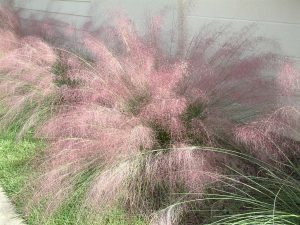
by Mary Salinas | Aug 29, 2018
Versatile, easy-care, beautiful, native – what’s not to love about muhly grass?
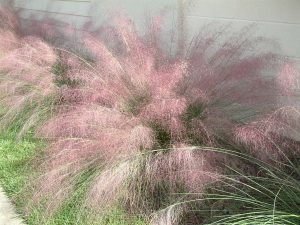
Muhly grass is a hardy landscape choice with dramatic fall blooms. Photo credit: Carrie Stevenson, UF IFAS Extension
How is it versatile? It makes a perfect border along a fence or structure. Plant it in a single or double row depending on available space. Use a single plant as a specimen in a smaller landscape. Muhly grass can also be planted in mass to serve as groundcover in a larger landscape.
What makes it easy-care? Since it only grows into a 3-foot-tall mound, there is no need to continually prune it as you would have to do for many landscape shrubs that serve a similar function. Plant muhly grass in areas where you only want to have plants grow to a 3-foot height, such as under windows or along a short fence. This clumping grass can be pruned in late winter to remove dead leaf blades, but it is not necessary. There are few pest and disease issues and its’ fertility needs are low. This tough plant can handle both drought and inundation with water. Perfect for a rain garden! Flowering is best in full sun, but it can take part sun as well.
What’s so beautiful about a grass? In the fall, abundant pink to pinkish/purple blooms cover the canopy of the grass and add color to the fall landscape. The wispy blooms move with the breezes and add interest with their movement. The new cultivar ‘Fast Forward’ blooms as early as August and into the winter. If pink is not your color, there is a form with white blooms known as ‘White Cloud’.
Consider adding some muhly grass to your landscape. You will love it as I do.
by Mary Salinas | Jul 11, 2018
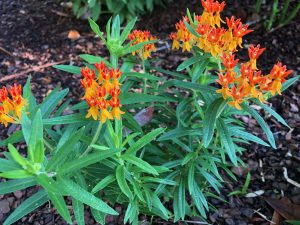
Butterfly Weed – Photo courtesy Mary Salinas
Butterfly weed, Asclepias tuberosa, has been gaining in popularity in the perennials market as it attracts adult butterflies to feed on its nectar and monarch caterpillars to feed on its leaves. Gardeners are also turning to use more Florida native plants in their landscapes.
Independent or native nurseries tend to be the best source for plants but the supply can be quite limited. There are more sources for seed, though, online. Try to purchase seed from a local or Florida grower as those seeds will be better adapted to our climate.
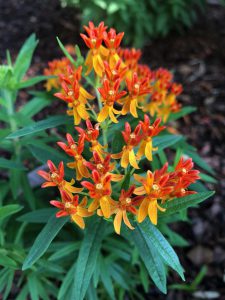
Butterfly Weed – Photo courtesy Mary Salinas
When growing butterfly weed from seed, transplant your new plants into their garden spot when they are still quite young, 2-3” tall, as they will be more successful in getting them established. Choose your planting location wisely. Once you plant it in a particular area, don’t move it. They are finicky about being moved from spot to spot.
For more information:
Monarch Butterfly
Asclepias tuberosa Butterfly Weed, Indian Paintbrush
Florida Wildflower Foundation
by Mary Salinas | May 23, 2018
A healthy lawn is a joy to stroll, relax and play on. It can also be part of an environmentally friendly landscape. But, sometimes it can seem to be a mystery on how to achieve that lush, healthy lawn in the Florida environment. Since we have lots of sandy soils and experience long periods of warm and hot weather, many suppose that giving the lawn lots of water will help do the trick. Not so.
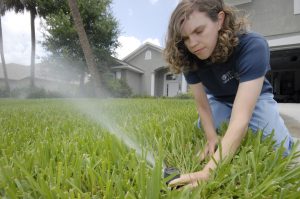
Photo credit: UF/IFAS.
But what harm can it cause to give the lawn plenty of water all the time? Isn’t that a good thing? No! Overwatering your lawn can lead to the following problems:
- Development of fungal diseases (fungi love a moist environment!)
- Increased insect pest pressure
- More rapid thatch development
- More weeds (those little emerging weed seedlings thrive on consistent moisture!)
- Some weeds, like dollarweed and sedges, can be an indication of overwatering
- A shallow root system when frequent, light watering is applied
- Washing away of fertilizer down into the soil past the root system
- Higher water bills.
Our lawns need, on average, about 1/2 to 3/4 “of water a week during the summer. This recommendation changes depending on soil type, shade, temperature, wind, and season. To figure out how long to run your sprinklers, watch this YouTube video from UF/IFAS.
We recommend running your automated system only when your lawn shows signs of needing water such as:
- Leaf blades fold
- The lawn looks ‘off-color’
- Footprints remain and are visible
For more information:
Watering Your Florida Lawn
Gardening Solutions: Irrigation
Your Florida Lawn








